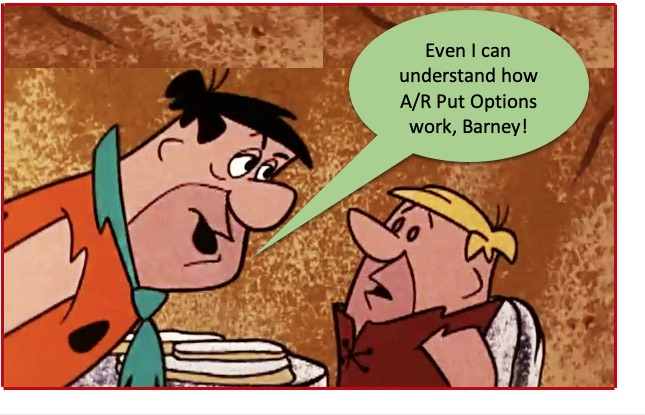
With all my years in credit risk management, one product that has come up from time to time which has a confusing name is “Accounts Receivable Put Option.”
When I hear the term “put option,” my mind thinks in terms of placing something somewhere. However, in the context of options, a “put” means the right to sell an underlying asset. So, it’s not about putting something somewhere physically, but rather about selling something in the financial markets.
This word “option” indicates that the investor has a choice or an option to buy or sell the underlying asset, but they are not obligated to do so. Again, the use of the word “option” itself can be confusing for people who are not familiar with financial jargon.
An Accounts Receivable Put Option (A/R put option) is a financial instrument that provides a company with the right, but not the obligation, to sell its accounts receivable to a third party. This right to sell is at a predetermined price, within a specified time frame, and based upon a particular event, which is namely, bankruptcy of the customer.
By using an A/R put option on a particular customer that may not be very creditworthy, a company can mitigate the risk of a non-payment by one of its customers, should it declare bankruptcy.
Here’s how it generally works:
Accounts Receivable Put Option Purchase: The company purchases an A/R put option from a financial institution (or finance company that specializes in this product). The customer, the fee rate, the duration, and many other terms and conditions are all detailed and executed through a put option agreement. This option gives the company the right to sell its accounts receivable on one customer to the option holder (the financial institution) at an agreed-upon price based upon a trigger event.
Exercising the Option: If the company’s customer does not pay their outstanding invoice(s) due to a formal declaration of bankruptcy (or insolvency), the company can choose to exercise the put option (which they always do). By doing so, the company sells the accounts receivable on the customer to the option holder at the predetermined face amount. In return, the option holder pays the company. It’s that simple.
Cost of the Put Option: The company pays a fee to purchase the A/R put option. This fee is the cost of the financial instrument and is typically determined by several factors such as the creditworthiness of the company’s customer, past and current financial performance, the amount of accounts receivable being covered, and the duration of the option period.
Here’s an example of the cost for a put option.
Face amount: $1 million
Coverage rate: 90%
Fee rate per month: 1.95%
Term (duration): 6 months
Based upon the above, if a company would like to purchase a $1 million put option, at a term of 6 months, to mitigate the risk of bankruptcy of its customer, the cost per month would be ($1,000,000 x .0195) = $19,500. The total cost for 6 months would be ($19,500 x 6) = $117,000.
In addition, with 90% coverage, should the customer declare bankruptcy within the 6-month period, the maximum amount that will be paid out against the outstanding receivable balance would be $900,000.
If the company invoices $1 million per month and gets paid within 30 days, it would cost $19,500 per month to cover $1 million in monthly sales.
Back in 2008 when the economic meltdown brought the auto industry to its knees, there were many suppliers to the major auto manufacturers that decided to purchase an A/R Put Option on one or more of the auto manufacturers. The manufacturers that were financially impacted included General Motors, Chrysler, Ford and even Toyota and Honda, which were relatively stable and financially secure companies. At that time, A/R put option rates were occasionally over 2% per month, indicating a high risk of bankruptcy.
It’s important to note some additional points about A/R put options:
- They cover the accounts receivable against only one customer at a time. This is different from credit insurance which can cover the accounts receivable on all or some of its customers.
- At the time of purchase, all existing current (no past due) accounts receivables can be included within the put option term (duration).
- Terms can be for 3 months, 6 months, 9 months, 1 year and even longer.
- They are usually purchased on publicly traded companies where financial statements are readily available to quote the fee. A/R put options can be purchased on privately held companies as well but it requires more extensive financial research and analysis.
- The fee rate is generally between .50% – 1.00% on the face amount per month. Fee rates close to 2.00% per month indicate a high level of bankruptcy risk.
- Coverage rates can vary be between 80% – 100%.
A/R put options can be a valuable credit risk mitigation safety net for companies, especially those operating in industries where late payments or defaults are common. Since Covid, suppliers to large consumer retail chain stores and restaurants have purchased A/R put options to cover their customers in this sector.
One final note, as the A/R put option agreement can be lengthy and legally complex, it’s best to have your corporate counsel review it.
Hope the above gives you an understanding of A/R put options, which may at some point be another one of your credit risk management tools in your toolbox.
Your questions and comments are most welcome (nseiverd@cmiweb.com).
Nancy Seiverd, President, CMI Credit Mediators, Inc.

